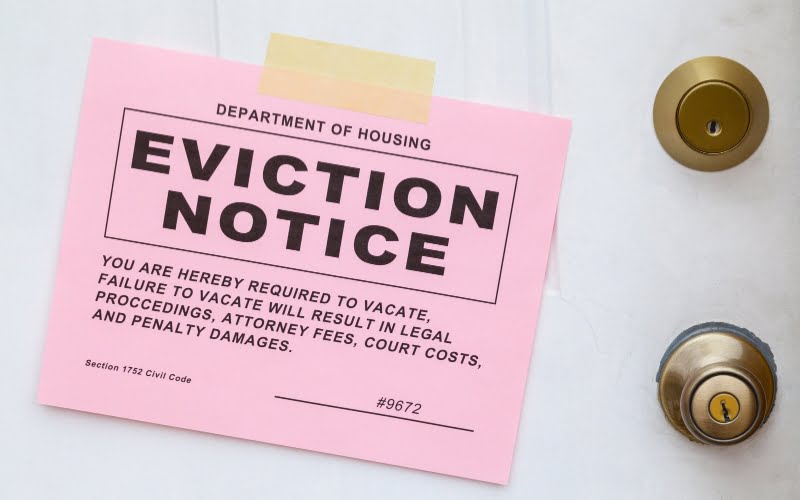Last Updated on March 18, 2024 by Kelvin Nielsen
Are you a California landlord and are looking to evict a tenant on a month-to-month lease? If so, this blog has you covered! Read on to find out the steps you must take to evict the tenant successfully.
California law (CA Civil Code 1940-1954.06) grants landlords the right to evict a tenant in certain situations. Among these is evicting a tenant on a month-to-month lease.
You may no longer want to continue renting to the tenant for various reasons. It could be that the tenant has become delinquent and is no longer meeting their rent obligations. The tenant may also have made unauthorized property alterations.
You may also want the tenant to leave because of violating the lease agreement, such as keeping an unauthorized pet. It’s also possible that you may be looking to sell the property. The reasons could be many and varied!
But whatever the reason you have, the eviction process must strictly follow the law. You must not try to engage in illegal eviction methods, such as throwing the tenant’s belongings out, locking them out, or shutting down their utilities. These are examples of “self-help” eviction methods and are illegal.
The only way to successfully evict a tenant in California on a month-to-month lease is by obtaining a court order (Writ of Possession).
In this blog, we’ll walk you through everything you need to do to conduct a successful eviction process.
How to Evict a Tenant in California on a Month-to-Month Lease
The following is the step-by-step process that you must follow.
Step #1: Serve the month-to-month tenant with a proper eviction notice.
In California, to evict a tenant on a month-to-month lease, you must serve them a 30-Day Notice to Vacate. The notice also applies when trying to evict a holdover tenant or a tenant with no lease.
If the tenancy is less than a year old, you must serve the tenant a 30 calendar days’ notice to vacate. But where the tenancy is 1 year or more, you must serve the tenant with a 60 calendar days’ notice to vacate.
If the tenant doesn’t move out after the expiry of the notice period, you can continue with their eviction.
Please note that you must serve the notice in a manner prescribed by state law. The following are the options you have.
- Hand a copy to the tenant in person.
- Hand a copy to a person of a suitable age AND mail another copy to the tenant via certified or registered mail.
- Post a notice on the entry door, or any other conspicuous area at the premises.
Make sure to keep the original copy, as well as a declaration of service should you require to adduce evidence in court.
Step #2: File an eviction lawsuit with the Superior Court of the applicable county in California.
If the notice period ends and the tenant is still on the property, you can continue with their eviction by filing an eviction lawsuit against them. In court, you’ll need to file an Unlawful Detainer lawsuit.
Filing an Unlawful Detainer lawsuit in California will set you back between $240 and $435 in fees.
Make sure to properly fill in all the required information. Including, you and your tenant’s contact info, the property’s location and address, tenancy type, and the ground for eviction. You may also need to attach a copy of the lease, eviction notice, and return receipt for the mailer.
Step #3: Have the tenant served with a copy of the Summons and Complaint.
Unlike an eviction notice, a Summons and Complaint must be served by a process server. You have up to 60 days to have the tenant served after filing the eviction complaint. If you don’t, you risk having the case dismissed by the court.
The summons and complaint must be served on the tenant by any of the following methods.
- Serving the copy to the tenant in person.
- Leaving a copy at the tenant’s place of work during normal business hours AND mailing another copy to the tenant by first class mail.
- Posting a copy on the entry door, or any other conspicuous area on the property.
Once this is done, the tenant will then have a chance to respond to the allegations. The tenant will have five-ten business days to file the answer. In their defense, the tenant may try to stop or delay their eviction by providing any of the following defenses.
- Their eviction was due to their race, color, religion, nationality, or any other protected class.
- Their eviction was a retaliatory action for exercising a legal right. When it comes to repairs, for instance, California renters have a right to withhold rent, or repair the issue and then deduct the costs from future rent payments, among other legal options.
- The eviction process was illegal.
- The eviction process had substantial errors.
If the tenant failed to respond, you can ask the court for a default judgment without having to attend the hearing. However, if the tenant did respond, then you’ll need to file a hearing request.
Step #4: Attend the court hearing.
Typically, eviction hearings in California are held within 20 days of filing a hearing request. It goes without saying that you should adequately prepare for the hearing by carrying all relevant evidence.
Including, a copy of the lease, eviction notice, summons and complaint, and even witnesses (if any).
If the outcome of the hearing is in your favor, you’ll need to obtain a Writ of Execution.
Step #5: Removal of the tenant.
A Writ of Execution is the tenant’s final notice to leave the property. In California, a Writ of Execution gives a tenant up to 5 days to leave. After which, the sheriff will have to forcibly eject them and return possession back to the landlord.
The tenant may also be able to delay their eviction by filing a stay of execution.
Frequently Asked Questions (FAQs): How to Evict a Tenant in California on a Month-to-Month Lease.
Q: Does a lease automatically go month to month in California?
A: Yes! Under California law, after a one-year lease expires, the tenancy automatically becomes month-to-month, unless both you and your landlord renew the lease again.
A month-to-month lease automatically renews every month until either party terminates it by serving the other a 30 days’- or 60 days’ notice.
Q: Can a landlord terminate a month-to-month lease without cause in California?
A: Yes! Terminating a month-to-month lease doesn’t require a landlord to have a ‘just cause’. That said, the reason for the eviction must not be due to discrimination based on the tenant’s protected classes, or retaliation after the tenant exercises a legal right.
Conclusion
There you have it – A step-by-step process on how to evict a tenant in California on a month to month lease. Trying to evict a tenant using any other way is bound to fail. You also risk getting sued for damages by the tenant.
Disclosure: The content herein isn’t a substitute for advice from a professional attorney. It’s only meant to serve educational purposes. If you have a specific question, kindly seek expert attorney services.
Sources: https://leginfo.legislature.ca.gov/, what is the difference between a month to month lease and a fixed-term lease, Illegal evictions, https://www.nolo.com/,

Hi, I’m Kelvin Nielsen, an experienced landlord and accomplished real estate lawyer. My focus is on answering your questions about renting in the hopes of making your life as a renter or a landlord a bit easier.







